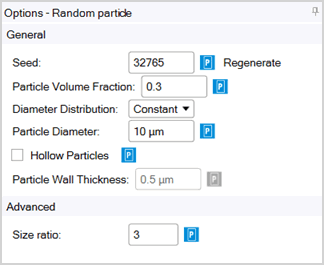Random particle reinforced composites consist of spherical particles arranged randomly in a matrix material. Besides the position, also the particles size can be randomly assigned following either a Uniform or a Log-Normal distribution.
The following options can be defined:
Seed: The seed number against which the random particle position and possibly diameter are generated.
Particle Volume Fraction: The fraction of space within the RVE that the particles occupy.
Diameter Distribution: The particle diameter distribution. Depending on the distribution type different parameters can be specified.
Constant: The diameter is fixed and set equal to Particle Diameter.
Uniform: The particle diameter follows a continuous uniform distribution with values in the range between Min Particle Diameter and Max Particle Diameter.
Log-Normal: The particle diameter follows a log-normal distribution whose mean and standard deviation are specified by Mean Particle Diameter and Std. Dev. Particle Diameter, respectively.
Note: Due to the limitations imposed by the RVE periodicity and the need to create a suitable mesh, the particle diameter is forced to be larger than a program controlled minimum diameter and smaller than half the unit cell size.
Hollow Particles: Generate hollow rather than solid particles.
Particle Wall Thickness: Wall thickness of hollow particles in the active unit system. This value has to be smaller than the radius of the smallest particle.
Size Ratio: The ratio between the edge length of the cubic unit cell and the average particle diameter.
Note: The particle volume fraction and the particle distribution moments are only reached approximately. See the status history after the generation of the RVE geometry for the actual values.



